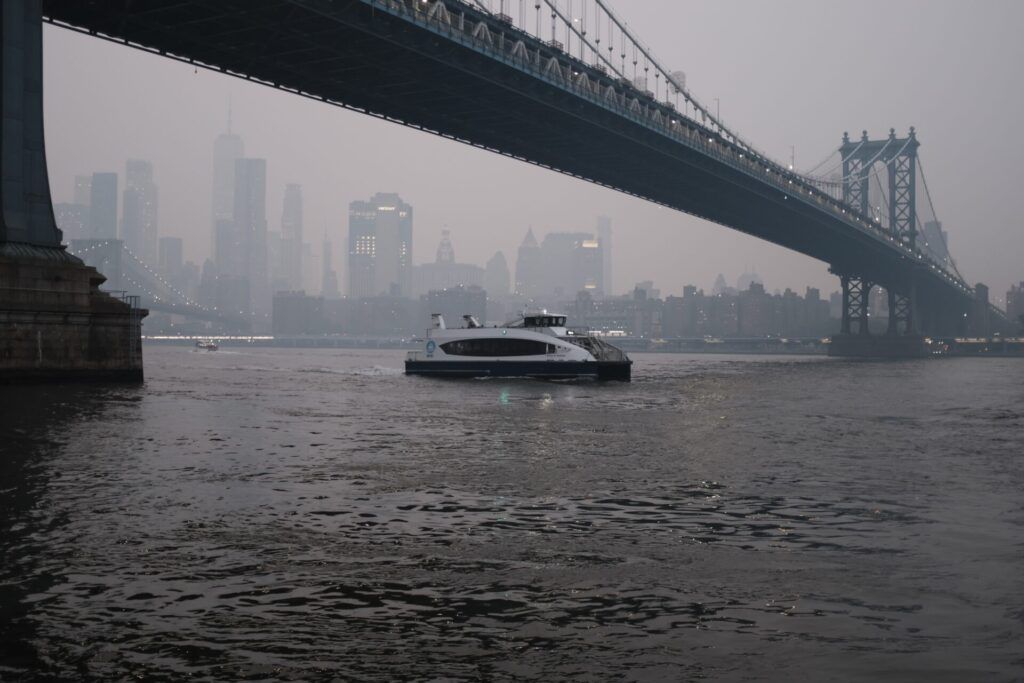Wildfires push air quality in East Coast cities almost off the charts
By Jessica McKenzie | June 9, 2023
 A NYC ferry passes under the Manhattan Bridge on Wednesday night, with the city shrouded in wildfire smoke. (Photo: Jessica McKenzie)
A NYC ferry passes under the Manhattan Bridge on Wednesday night, with the city shrouded in wildfire smoke. (Photo: Jessica McKenzie)
The East Coast was blanketed in smoke from wildfires in Canada this week. I can feel the burn and sting from the toxic smog in the back of my throat even now, after the air quality in Brooklyn has somewhat improved. My eyes became swollen, puffy, and irritated the morning after a masked walk.
In New York City, the Air Quality Index (AQI), a measure of air pollution and health safety risk, peaked at 484 on Wednesday evening, the highest ever recorded in the city. (The index only goes up to 500.) Philadelphia also surpassed 400.
Check out this almost unbelievable time-lapse of wildfire smoke consuming the World Trade Center and the New York City skyline.
Those vulnerable to poor air quality, including seniors and young children, should limit time outdoors if possible.
More: https://t.co/ChRuWv7X6E pic.twitter.com/mtKtLun8lN
— NWS New York NY (@NWSNewYorkNY) June 7, 2023
A Washington Post analysis found nearly 200 air quality monitoring stations recorded all-time high air pollution from wildfires by Wednesday. More than 100 million people were impacted by unhealthy levels of air pollution this week.
“This morning, millions of Americans are experiencing the effects of smoke resulting from devastating wildfires burning in Canada, another stark reminder of the impacts of climate change,” President Biden said in a statement Thursday morning, fully 48 hours after air quality in major US cities began to deteriorate. The statement went on to detail the firefighting support the United States is providing Canada, how the poor air quality is impacting air traffic, and instructed Americans to consult the Centers for Disease Control for advice on protecting themselves from the effects of wildfire smoke.
It fell quite a bit short of the “climate emergency” that environmental groups hoped the president would declare.
“New York City looks like it’s on fire, kids are choking on dirty air, and the AQI is a serious health threat equivalent to breathing in smoke from cigarettes. We are in a climate emergency, and it’s absurd that our government isn’t acting like it,” Varshini Prakash, executive director of Sunrise Movement, said in a statement. “President Biden, declare a climate emergency. How can you look at what’s going on and not take action?”
Other leading environmentalists, climate activists, and political representatives joined in the chorus calling for the president to declare a climate emergency, including the writer Rebecca Solnit, NASA climate scientist Peter Kalmus, and Congressman Ro Khanna (D-CA). Extinction Rebellion NYC announced a ‘funeral march’ would be held in Manhattan on Thursday evening.
Wildfire smoke is becoming, if not the new normal, then at least a semi-regular hazard for more Americans. A Stanford study last year found the number of US residents who experienced at least a day of unhealthy pollution from wildfire smoke increased 27-fold between 2006 and 2020. Some 25 million people experienced at least a day of unhealthy air pollution from wildfire smoke in 2020; the recent wildfires from Canada have already impacted four times as many US residents—and that doesn’t include the Canadians impacted by the fires or associated smoke.
Although not even halfway through the year, Canada is on course for its worst wildfire season ever. There were 437 active fires spread across nine of the country’s 13 provinces and territories on Thursday, with almost 250 burning out of control.
Together, we make the world safer.
The Bulletin elevates expert voices above the noise. But as an independent nonprofit organization, our operations depend on the support of readers like you. Help us continue to deliver quality journalism that holds leaders accountable. Your support of our work at any level is important. In return, we promise our coverage will be understandable, influential, vigilant, solution-oriented, and fair-minded. Together we can make a difference.
Keywords: Canada, air quality, climate crisis, smoke, wildfires
Topics: Climate Change














